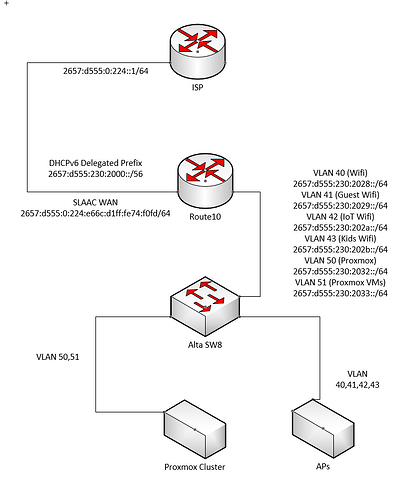I will start off with I don’t have my Route10 yet – I will be receiving it this weekend. But what i’ve gathered from a recent IPv6 post, and from the last webinar this feature isn’t currently implemented. So I figured i’d request it.
In my workflow I am getting a SLAAC assigned /64 from the interface of the upstream router, using that /64 the route10 would make a DHCPv6 request and DHCPv6 responds back with an assigned prefix delegation.
What would be nice to see if the Route10 take that learned PD and configure DHCPv6 to hand out from the PD internally without having to manually specify it, and of course reflect any changes from the upstream DHCPv6 router if the assigned PD changes.
Routers that act similar to this are ISP supplied Calix 4220, 4227, 4237, etc.
Realistically most people don’t know, or care, that they have IPv6 enabled on their network. It only really becomes an issue with CGNAT and power users, which those power users might also want the ability further subnet from the assigned PD, but that is a different issue. Though it would be a cool feature for example to take an assigned /56 PD from DHCP and automatically assign a /64 from it for each vlan.
Welcome!
What you’re describing is more or less how Route10 works if I’m following you. If you have DHCPv6 enabled on WAN, and enable the IPv6 toggle on a VLAN, then a /64 from your PD will be assigned to that VLAN. That will be used for both SLAAC and DHCPv6 for clients. Each VLAN which has the IPv6 toggle enabled will get a /64, until you run out of /64s in your PD. Does that cover what you’re looking for?
IPv6 on VLANs does default to ‘off’ rather than ‘on’, though there’s no harm enabling it even when you don’t have an IPv6 WAN (it ends up ignored), but that’s the only discrepancy I see.
Sub-delegation (what I presume you mean by further subnetting from the assigned PD) support does not exist currently. That’s generally an ISP router function rather than a customer-side router function, and it’s rare to find it on the latter. Granted, I’m saying that as someone with multiple levels of sub-delegation in my work-from-home lab.  But the lab requirements for developing networking products, and the user requirements for using said products, are vastly different there for most people. Might be something we add support for down the road if demand materializes. It’s come up a few times in my 20+ years of building router products, but is a rare request relative to many other things.
But the lab requirements for developing networking products, and the user requirements for using said products, are vastly different there for most people. Might be something we add support for down the road if demand materializes. It’s come up a few times in my 20+ years of building router products, but is a rare request relative to many other things.
1 Like
I might be explaining it wrong. I’ll be able to see better I guess after it arrives on Sunday.
As for the ISP grade stuff. I work for an ISP so I tend to view things through that lens a little, and I lab on myself 
Thanks!
Are you looking to delegate part of your PD to a router whose WAN is on your LAN? That’s what I’m referring to by sub-delegation. Main router gets /56 from ISP. Then enables assigning portions of that via PD to devices on LAN which request their own PD, and automatically handles dynamic routing of it.
My home/work lab setup does that via VyOS, as it nicely and easily supports every possible WAN type with IPv4 and IPv6 (once I fixed some of it myself and got it merged upstream at least), and its REST API is handy for automated testing (force reconnect of PPPoE, force DUTs to change DHCP or PPPoE IP, blackhole route them for WAN failover testing, etc.). I use a static /48 from HE.net because the /56 I can get from Google Fiber just isn’t remotely enough IP space when you have several dozen routers. I delegate /60s to most everything, so anything short of a /48 isn’t viable.
In the future I hope I can replace that VyOS system with a Route10, but the ISP-focused features I need in that context in my lab aren’t high on our priority list at the moment. Regardless, would be glad to hear more about what you’re looking to achieve.
1 Like
In this example the Route10 would be the router directly connected to the ISP demarc.
Route10 would get it’s IPv6 address via SLAAC from the upstream router, a /64. ISP DHCP server delegates a /56 prefix.
Then each vlan internal would have it’s own /64 out of the /56 delegation.
My home “lab” is always in flux. Like I was saying before, I tend to test things for work ( at the ISP ) on myself at home. When I was deploying CGNAT, I had cgnat, which is when I started pushing ipv6, when we started deploying multi-gig xgs pon, tested that on myself as well. In that test my router changed a few times, I tried the Calix GS4237 which is a combo residential gateway and ONT, and then I went to a two-box solution with an indoor 10G ONT. I built a pfsense router with 10G connections, then eventually moved to a mikrotik, and now soon a route10.
1 Like
